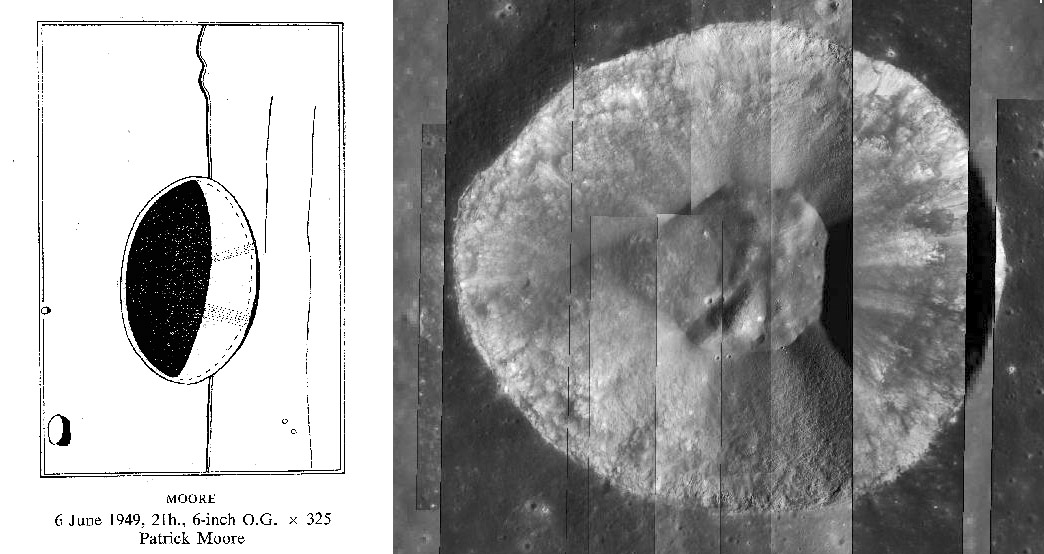December 15, 2012
Moore

drawing from The Moon by Dr H. Percy Wilkins, F.R.A.S. and Patrick Moore, F.R.A.S., 1955,p. 131, and LRO image from QuickMap
Sometime back in about 1950, whilst he was an active lunar observer, Patrick Moore took the liberty of naming a crater on the Moon after himself. Obviously the name never stuck, but now with his passing I believe that a fitting tribute to him would be the reinstatement of his name to this crater. In his 1953 book, Guide to the Moon, Patrick Moore describes the crater Moore as, A small crater 12 miles across, east of Bullialdus. It interrupts a prominent cliff. There are two dark radial bands to the inner east wall.
In the later 1955 The Moon tome in conjunction with H Percy Wilkins, Patrick describes the crater Moore as follows:
MOORE, -437 -395 [English selenographer and one of the Authors, 1923 - ]. This was formerly known as Agatharchides A, and lies to the north-west of Hippalus on the most westerly of the three great valley-clefts on the western side of the Mare Humorum. There is some object on the western part of the floor, probably a hill and also two dusky bands on the inner east wall, discovered by Moore with a 6-inch refractor in 1949. With the great 33-inch Meudon refractor, Moore saw some small bright and circular patches inside the crater; the general effect is very much like a miniature Aristarchus... A modern co-ordinate lunar location for Agatharchides A is Latitude 23.2°S and Longitude 28.4°W. The diameter of Agatharchides A is 16 km.
Graeme White
Notes by CAW: Moore's simple drawing and description accord well with the detailed LRO image (rotated to have south up as in lunar maps before 1960). There are a number of low albedo landslide areas on the crater's right inner wall; simplifing that complexity into two dark bands seems acceptable. The statement that there is an object, probably a hill on the western (right) side of the floor is not quite right positionally, but indicates correctly that the crater floor is not simply flat with a small central peak.
Graeme's suggestion that this crater be named Moore would break two IAU nomenclature rules: that lettered craters not be renamed, and that duplication of names is not allowed - another Moore already exists. It is possible that in 3 years the IAU might agree to add Patrick Moore as a person honored by the existing farside Moore crater.
Related Links
Rükl plate 53
21st Century Atlas chart 23.
Yesterday's LPOD: Liftoff To the End
Tomorrow's LPOD: Too Faint?
COMMENTS?
Register, Log in, and join in the comments.



